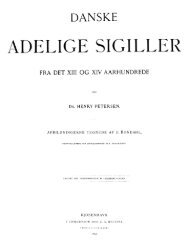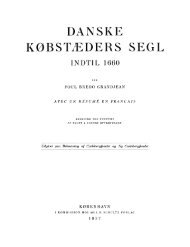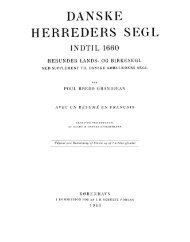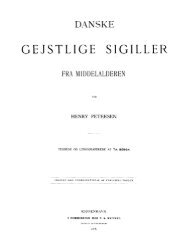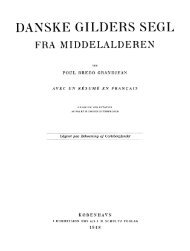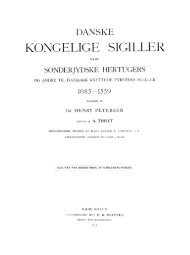Oldtidsagre - Genstandskundskab
Oldtidsagre - Genstandskundskab
Oldtidsagre - Genstandskundskab
Create successful ePaper yourself
Turn your PDF publications into a flip-book with our unique Google optimized e-Paper software.
Nr. 1 167<br />
VAN GIFFEN has also found remnants of prehistoric cultivations beneath an<br />
Iron Age dwelling site and grave mound at Rhee, near Zeyen. No field-divisions<br />
were seen here, but distinct traces of ploughing, running in two directions, perpendicular<br />
to each other (Nieuwe Drentsche Volksalmanak 1940, p. 19, Afb. 17 and 19),<br />
just as beneath the Jutland sites Alrum and Nørre Fjande (HATT 1941). VAN GIFFEN<br />
is undoubtedly right in his opinion, that these plough-furrows were produced by a<br />
primitive plough (“HakenpIlug"). Here as in Jutland, ploughing was done with an<br />
arð in two directions. It is evident that this system of ploughing implies broad fields.<br />
It is still more interesting that VAN GIFFEN has found similar P-l()llgll-1`llI`l`()\\'S<br />
beneath a grave-mound from the Late Stone Age (c. 1600 B.C.) at Gasteren in Anloo<br />
parish, northeast of Assen (VAN (IIFFEN 1941, p. 30 and Afb. 31). 'l`his proves that<br />
ploughing with arð in two directions was done already in the Late Stone Age.<br />
Finally it should be mentioned that VAN (in-*F15N has found similar pIough-furrows<br />
beneath a grave-mound in Zwaagdijk in \VerVershoof parish in the province<br />
of Noord Holland (VAN GIFFEN 1944, p. 123 and 132, Afb. 9).<br />
In his publication from 1944, VAN GIFFEN compares the Dutch finds with the<br />
Jutland finds, and he observes that the oldest instances (Gasteren amt \\'erVershool`<br />
in Holland, Vesterlund in Jutland) have less continuous furrows, while the younger<br />
instances (Rhee in Holland, Alrum and Nørre Fjande in Jutland) have more continuous<br />
and heavier furrows. From this, he draws the conclusion that the older furrows<br />
were made with a comparatively primitive arð of the digging-stick type, the<br />
younger furrows with an arð of more advanced type (Van GIFFEN 1944, p.160).<br />
Strangely, no ancient fields of the “Celtic field"-type have been found in North<br />
\Vestern Germany, although the natural conditions remind of \Vest Jutland. I have<br />
searched for “()ldtidsagre“ in Lüneburger Heide, with a negative result. Deserted<br />
fields of the “Hochäcker"-type are very common in Lüneburger Heide; ancient fields<br />
of the “Celtic field"-type are apparently absent. A British expert has also looked in<br />
Vain for “Celtic fields" in the Lüneburger Heide (BARGER 1938, p. 403, note 3).<br />
As a set-off, a very considerable age has been ascribed to the “Hochacker" in<br />
North \Vestern Germany. However, the proofs advanced by HANS MULLER-BRAUEL<br />
(MANNUS 1926, p. 184-189), dating certain “Hochäcker” between Elbe and \Veser to<br />
Late Stone Age, seem to be doubtful or insufficient. However, BARGER relates that<br />
German archaeologists have been able to date certain prehistoric strip-fields at Hodorfan-der-Stör,<br />
east of the estuary of the Elbe, to the latest La Tène period (BARGER<br />
1938, p. 399).<br />
Deserted “Hochäcker” are also found in other parts of Germany, and in some<br />
cases a considerable age has been ascribed to them. Especially, certain “Hochäcker"<br />
in Southern Bavaria have been much discussed. Cf. BIANNUS 1911, p. 344. The later<br />
investigations of Bavarian “Hochäcker" are mentioned by BARGER (1938, p. 400).<br />
A Bronze Age date cannot be established for these fields. Apparently, they belong<br />
to the Germanic period; Pre-Roman or Roman objects, found in connection with the<br />
“Hochäcker“, antedate these in almost every case.<br />
22*



